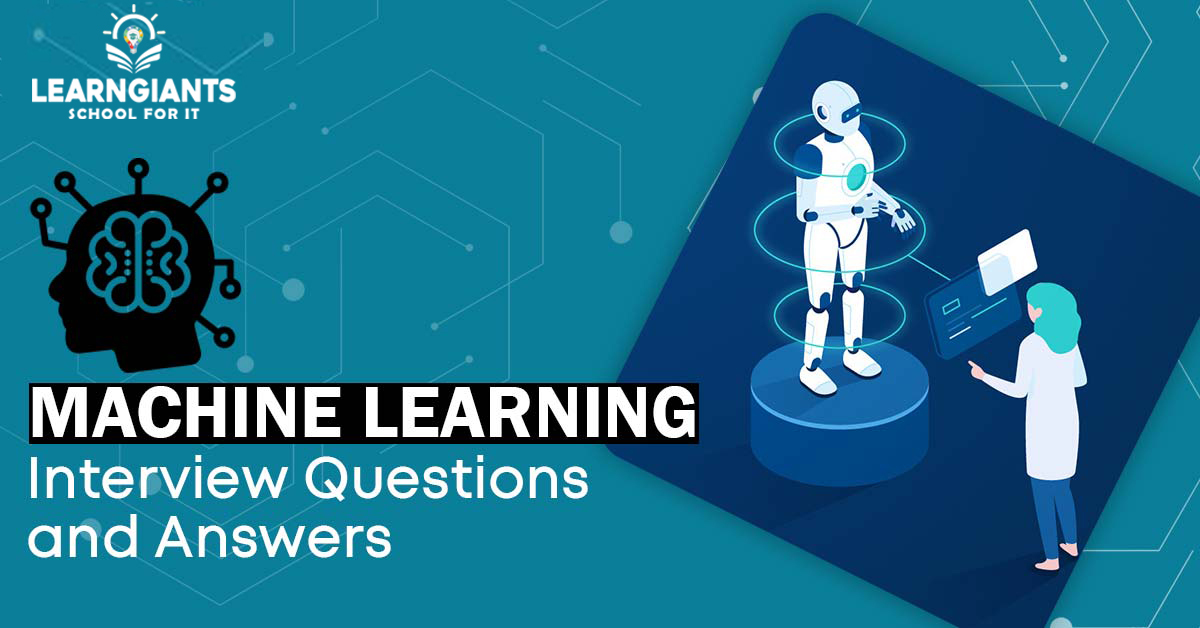Machine learning Interview Questions and Answers

1. What do you mean by Machine learning?
Machine learning is an IT field that focuses on machine programming to understand and develop knowledge automatically. For instance: bots are designed to accomplish the mission on the basis of data they obtain from detectors. It develops programming from user information.
2. Name a few machine learning algorithms
Decision Tree,Neural Networks ,Nearest Neighbor,Probabilistic networks,Support vector machines.
3. Explain the types of machine learning
Supervised Learning: Machines train under the guidance of designated data in this form of machine learning technique. The machine is focused on a testing dataset and provides its performance according to its preparation.
Reinforcing Learning: reinforcement learning requires models which learn and cross to create the best step possible. In order to seek to determine the next possible course of action, algorithms for reinforcement learning are built on the basis of reward to punishment theory.
Unsupervised learning: it does not have unlabeled results, unlike supervised learning. There is therefore no monitoring under which the data are being processed. Uncontrolled learning essentially tries to identify data patterns and create similar entities clusters. Once the model is reached with new input details, it does not identify the entity; rather, it positions the entity in a community of related objects.
4. Explain inductive logic programming
Genetic programming is among the multiple computer learning methods. The algorithm is designed to evaluate and pick from a range of outcomes the best alternative.
5. What do you mean by model selection?
The selection method between features of various computational frameworks that are used to represent the same dataset is referred to as the model selection. The application of models is implemented in analytics , machine learning and data analysis areas.
6. Give one advantage and disadvantage of decision trees
Benefits: Decision trees (which ensures that they're resilient to outlines) are simple to interpret, non parametric, and relative parameters can be modified.
Disadvantage: Decision trees are unable to overfit. Yet ensemble approaches such as random forests or enhanced trees may fix this.
7. Explain cross validation
Cross-validation is primarily a method used to test the efficiency of a concept on a different and independent basis. The easiest method for cross-validation is by splitting the data into two groups: training data and test data, using the training data for model creation and testing data for model research ..
8. What is a classifier?
A Machine Learning classifier is a program that inputs a matrix of distinct or cumulative significance of the function and outputs a single discrete class value.
9. What is the advantage of a Neural network?
Neural networks, in particular, deep NNs, have contributed to breakthroughs in output for unorganized databases including images, sound / visual. The unbelievable simplicity helps them know patterns, which no other ML algorithm can do.
10. What is Principle Component Analysis?
PCA is a tool of integrating features in unrelated linear combinations for turning features into a data collection. These new features or main components sequentially optimize the defined variation (i.e. the first main component is most variant, the second most significant version, etc.). It implies that PCA is valuable for raising dimensionality, since an adjustable variance limit is feasible.
11. What are Random forests?
Random forests are an array of decision-making processes. Random forests require the development of several judgment gems by bootstrapping original data datasets and the random collection of a subset of variables at each stage. Afterwards the algorithm selects the mode of a Decision Tree prediction. This reduces the chance of an person tree mistake by utilizing a formula "vote wins."
12. When do you use Random forests?
Random forests will decide the value of your app. It can not be achieved by SVM.Random forests are simpler and easier than an SVM to build.SVMs need a one-vs-rest approach for numerous classification issues, which is less sized and more resource consuming.
13. Explain kernel
A kernel is a way to measure the point product in any (possibly very high-dimensional) field of two vectors xx and yy, which is why kernel functions are often named "generalized point product."The network model is a way to address a highly nonlinear question by converting linear regression data into linearly segregated data in higher dimensions.
14. Explain overfitting
In computer analysis, a random error or noise is represented by a mathematical model instead of an underlying 'overfitting' relationship. When a model becomes too complicated, overfitting may typically arise because the amount of training data types contains so many parameters. The layout is badly implemented and overcrowded.
15. How is data mining different from machine learning?
The research, product development of the algorithms allowing computers to work without specific programmatization contribute to machine learning. Data mining may, however, be described as the method in which data attempts to obtain information of unknown trends. Training algorithms are used in this method computer.
16. Explain parametric models
The structures with the minimal amount of parameters are parametric structures. You just have to learn the performance of the network to predict new results. Examples cover linear regression, functional and linear SVM regression.
17. What is a REgression?
It is the method of constructing the model to separate data from groups or distinct values into continuous actual values. Based on the historical evidence, it may also describe the propagation motion. This is used to forecast an occurrence based on the degree to which the factors are mixed.Of eg, the weather prediction relies on variables including temperature , air currents, solar radiation, region elevation and sea distance. The interaction between these variables allows one to forecast the environment.
18. What do you mean by confusion matrix?
The confusion matrix is used to describe the success of a process and includes an overview of the category issues forecasts. It helps in the determination of class unpredictability.
19. Explain variance and bias
Bias is the discrepancy between our model's average and the correct one. The model's forecast is not reliable when the bias value is strong. The bias factor would also be as small as practicable in order to produce the required predictions.Variance is the sum that shows the disparity between a forecast and the predicted value of certain sets of instruction. High variance may contribute to major production variability. The performance of the model will therefore be small.
20. What do you mean by linear regression?
Linear regression is a guided algorithm for machine learning. This is used for statistical modeling to locate causal connections between the addictive and the independent variables.
21. What is the importance of rotation in PCA?
Rotation is a major step in PCA since it maximizes the separation of components within the variance. It makes it easy to understand the elements.The explanation why PCA is used is to pick fewer components that can describe the largest variation in a data collection. The initial positions of the points are modified when rotation is done. The relative location of the elements, however, is not modified.If the components are not rotating, the variation needs to be represented with extended components.
22. Explain k-means cluster
It is an unattended algorithm in machine learning. Here we provide the model with unidentified (unlabeled) details. The algorithm then produces loads of points dependent on the average distances of various points.
23. Explain Bagging
We use random sampling and then divide the data set into n. Afterwards, we construct a model of one training algorithm. They instead merge actual survey forecasts. Sackaging aims to boost the model 's efficacy by raising the variation from overriding.
24. What do you mean by Standardization?
The approach used for rescaling device attributes is standardisation. The attributes will have a mean value of 0 and a minimum value of 1. The primary goal of standardization is to speed up the composite and standard attributes variance.
25. What are Support Vector Machines?
SVM is an algorithm used primarily for classification of machine learning. The signature function is placed over the strong dimensionality.
26. What is Logistics regression?
Logistic regression describes the right application of regression where a categorical or conditional dependent variable is used. Logistic regression is, like other regression analyzes, a statistical modeling method. The data and the relation from one contingent random vector and one or more variables is clarified using a logistic regression. The expectation of a categorically contingent variable is often used to forecast.
27. What are different types of Logistic regression?
Three kinds of logistic regression emerge:
Binary logistic regression: only two results are probable in this sense.Example: To determine whether (1) or not (0) is going to rain
Multinomial logistics regression: For this the performance consists of three or four unordered groups.Example: Local language prediction (Kannada, Telugu , Marathi, etc.).
Ordinary logistic regression: the output comprises of three or more organized groups, in the ordinary logistic regression.Example: ranking an app from 1 to 5 stars for Android.

 WhatsApp Us
WhatsApp Us